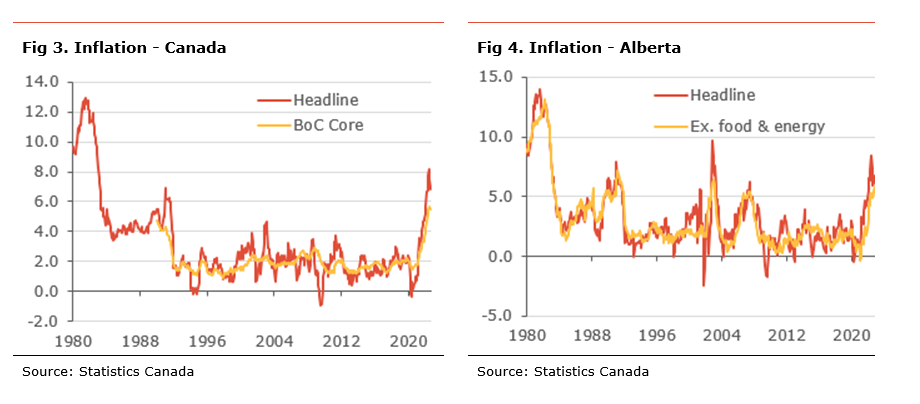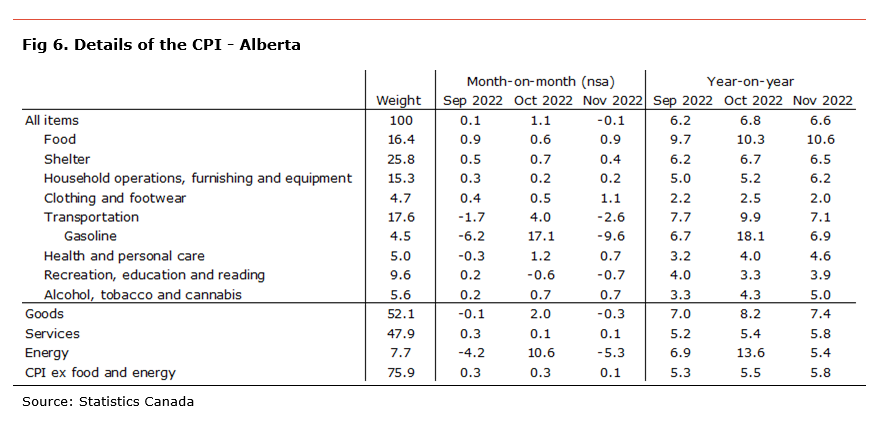Economic insight provided by Alberta Central Chief Economist Charles St-Arnaud.
Bottom line
Inflation moderated in November at the elevated level of 6.8%. However, the headline number covers some divergences in the components, with a moderation in transportation costs, due to lower gasoline prices offsetting an acceleration in food and shelter costs and some other components. Inflationary pressures remain broad, with almost 80% of the components of CPI rising at more than 3% y-o-y, and more than 60% at more than 5% y-o-y (see Fig 1). The share of CPI components rising by more than 5% increased slightly in November, suggesting a slight broadening in inflationary pressures. This likely explains why measures of core inflation increased in November.
The recent trend in the CPI monthly changes suggests that inflationary pressures have gained some momentum in recent months. However, the 3-month annualized change in most CPI components remains below their year-on-year changes, except for food prices and shelter cost, suggesting that inflation should continue to moderate (see Fig. 2). However, the 3-month annualized changes remain elevated and well above 3%, the upper end of the BoC’s target for most categories, with CPI ex food and energy at 4.3%. We note that inflation ex. food and energy have been relatively stable, around 5.3% since May 2022.
While inflation may be peaking, it remains well above the BoC’s target of 2%, inflation expectations are rising, and inflationary pressures remain broad and sticky. With this in mind, this CPI report is likely to be a small disappointment for the Bank of Canada which was likely hoping for a weakening in underlying inflationary pressures. In our view, this increases the odds that the BoC will likely increase its policy rate by 25bp at the January meeting. However, the decision is likely to depend on other incoming data, especially the next employment report (Jan 5th) and the next CPI release (Jan 17th).
In Alberta, inflation rose to 6.6%. A deceleration in transportation costs, as gasoline prices eased on the month was the main cause of the decline in inflation, while a continued rise in food and shelter costs were the main source of inflation. Inflation excluding food and energy (a measure of core inflation) rose to 5.8%, its highest since 2003. We note that core inflation in Alberta significantly able the rest of the country for the first time since 2020.
The Consumer Price Index (CPI) increased by 0.1% m-o-m non-seasonally-adjusted in November and the inflation rate moderated to 6.8, less than expected. Prices rose on the month in five of the eight major CPI components, with recreation, education and reading (-1.3% m-o-m), clothing and footwear (-0.4% m-o-m) and transportation (-0.9% m-o-m), due to lower gasoline prices, showing a decline on the month. The biggest increases were in food (+1.2% m-o-m), health and personal care (+0.8% m-o-m) and shelter (+0.6% m-o-m). The rise in the shelter component was mainly the result of higher mortgage interest costs and rents.
Six of the eight major CPI components accelerated in November on a year-on-year basis, led by food, health and personal care, and shelter cost. Shelter costs accelerated to 7.2% y-o-y and are the biggest source of inflation, contributing 2.2 percentage points (pp) to headline inflation, mainly due to higher interest cost, rent and homeowners replacement costs. Food prices accelerated to 10.3%, its highest since 1981, contributing 1.7pp to inflation. Transportation costs decelerated to 8.5% y-o-y, contributing 1.6pp to inflation, with gasoline prices being the primary source of cost decreases in the category (-3.6% y-o-y contributing 0.6pp).
In October, goods prices inflation decelerated to 8.0% from 8.4%, mainly due to lower gasoline prices, and services inflation rose to 5.8% from 5.4%. Energy prices decelerated, increasing by 13.9% since November last year. Excluding food and energy, prices increased 0.1% on the month and rose by 5.4% compared to the same month last year, marking a slight acceleration. The Bank of Canada’s old measure of core inflation, CPI excluding the 8 most volatile components and indirect taxes, was unchanged at 5.8%.
Looking at the BoC’s core measures of inflation, two out of three accelerated in November. CPI-Median rose to 5.0% from 4.9% and CPI-Common to 6.7% from 6.4%. CPI-Trim remained unchanged at 5.3%. The average of the core measures edged higher to 5.7%.
In Alberta, inflation moderated to 6.6% in November from 6.8%. Lower transportation costs were the main reason for the decline in inflation and increased by 7.1% y-o-y and contributing 1.3pp to inflation. Lower gasoline price were the main reason for lower transportations cost. Shelter costs also deccelerated on the month, rising 6.5% y-o-y from 6.7%, contributing 1.7pp to inflation. The higher cost for rented accommodation and owned accommodation remain the main source of prices pressures in the sector. Food prices rose 10.6% compared to last year and remain an important source of inflation, contributing +1.7pp. Goods price inflation decelerated to 7.4% from 8.2%, while services prices rose to 5.8%. Inflation excluding food and energy rose to 5.8%, its highest level since 2003, while energy costs to +5.4% y-o-y compared to the same month last year, after 13.6% y-o-y the month before. This is the slowest y-o-y increase in energy pries since January 2021.





Independent Opinion
The views and opinions expressed in this publication are solely and independently those of the author and do not necessarily reflect the views and opinions of any organization or person in any way affiliated with the author including, without limitation, any current or past employers of the author. While reasonable effort was taken to ensure the information and analysis in this publication is accurate, it has been prepared solely for general informational purposes. There are no warranties or representations being provided with respect to the accuracy and completeness of the content in this publication. Nothing in this publication should be construed as providing professional advice on the matters discussed. The author does not assume any liability arising from any form of reliance on this publication.
Alberta Central member credit unions can download a copy of this report in the Members Area here.